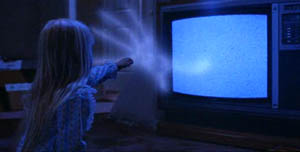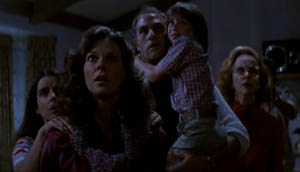|
So I was twelve years old, and had been borderline traumatized by John Irvin's Ghost Story the previous summer, but viewed this upcoming "Poltergeist" movie with a curious eye. Spielberg's name was attached and it was only rated PG, after all. How scary could it be? What I didn't know was that it had only just barely undershot the R rating on appeal from Spielberg, and that the actual director (years of subsequent speculation to the contrary notwithstanding) was Tobe Hooper, who had directed The Texas Chainsaw Massacre. Did not know that at all. So I didn't sleep too well that night, or for several nights afterwards. Yet the film had a magnetism to it that wouldn't easily let me go. 
Poltergeist is one of the all-time great haunted house movies, a film which is remarkably affecting in spite of the fact that oftentimes it verges on the absolutely preposterous. The original ad line for the film was "It knows what scares you." It was an audacious bit of promoting aimed clearly at the audience, but it also succinctly summed up the theme of the movie. Fears vary widely between different people and at different ages. The hapless Freeling family must come face-to-face with what terrifies them the most. For the children, it's the abstracted predator-fear that afflicts all of us at a young age: fear of creeping horrors lurking in dark closets or under our beds. For the parents, the fear they must confront is one far more tangible: losing a child and having no idea how to find or retrive her. 
The Freelings' family home is not, to coin a phrase, a slightly haunted house. Hill House, from Shirley Jackson's novel and Robert Wise's film adaptation The Haunting, was a slightly haunted house, inspiring speculation as to whether ghosts were even meant to be truly present. The oft-filmed Henry James novel The Turn of the Screw is also ambiguous about its supernatural underpinnings. The Freeling house is so throroughly beset by spirit activity that the film manages, if only once, to make it the punchline of a joke, as three parapsychologists arrive to investigate and find that they have no idea what's in store for them, especially that poor guy who goes off alone in search of a midnight snack. It manages to keep its wheels on the track by slowly earning these scenes. In a daring move virtually unknown in modern horror, nothing happens for the first half-hour. The typical family of five deals with sibling spats, a dead parakeet, the obnoxious construction workers digging a backyard pool, a neighbor whose TV remote keeps switching the channels of their own set during the big game, and other run-of-the mill issues in a California suburb, that classic Spielbergian bastion of all things normal. 
What happens next is the stuff of cinema legends. Carol Anne alone witnesses the arrival of the ghosts, who begin with a series of seemingly benign pranks before abducting the young girl into the ether. The house turns on its occupants, becoming a locus for all manner of bizarre manifestations. Some are strangely beautiful, while others are visions of horrid rottenness. The film tries nearly every possible ghost gag in the book, from Hitchcock's Vertigo effect creating an endless hallway, to mantis-like deformed skeletons with floating hair. Sometimes the clear enthusiasm to try everything pushes the film a little over the top. Other scares are more subtle, and more effective. When Carol Anne's disembodied voice proclaims, with quiet concern, "Mommy, there's somebody here," the room temperature drops a few degrees. What holds it all together is the film's own sympathies. It isn't a kill-fest, but a portrait of a devoted family in horrible crisis. We care what happens to them, because they so clearly care about each other. Some of the effects haven't aged well. The performances fortunately have, and solidly anchor the story. I have serious doubts that a modern update-which has been rumored-could succeed where this film does; look only as far as its own sequels. Poltergeist is a film for those who enjoy a good scare but who aren't sadistic assholes. Yes, I just made a broad generalization about fans of torture-fests. Bite me. -review by Matt Murray
|
|
||||||||